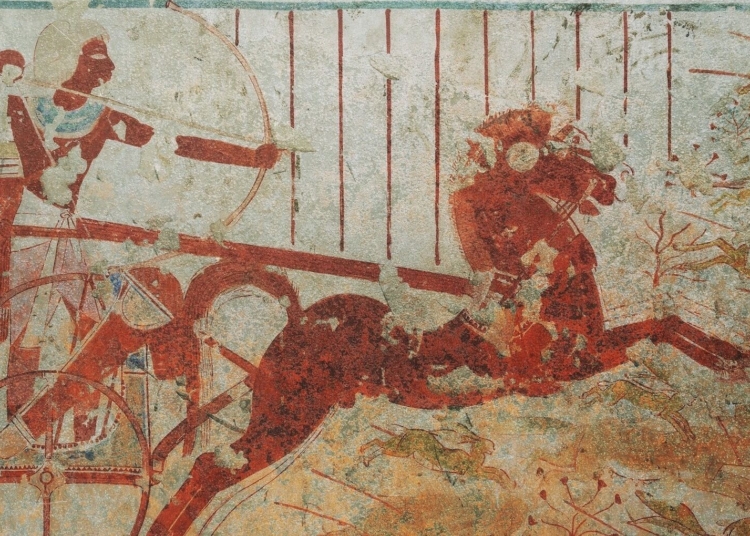The content introduces ancient warfare’s use of chariots and their importance in battle tactics. It highlights the origins of chariots, their tactical advantages, and their specific formation called the “scythe formation.” The psychological impact of chariots and the roles of the charioteer and archer are also discussed. The decline of chariot warfare with the rise of new military technologies, such as disciplined infantry units and heavy cavalry, is mentioned. The legacy and cultural impact of chariots, as well as their portrayal in the film “Chariots of Fire,” are explored. The conclusion reflects on the significance of chariots on the ancient battlefield.
Chariots of Fire: Ancient Warfare’s Fast and Furious Battle Tactics
Introduction
Ancient warfare was marked by various innovative battle tactics, one of the most renowned being the use of chariots. These majestic vehicles, pulled by horses and manned by skilled warriors, were the epitome of speed, power, and agility on the ancient battlefield. One of the most famous mentions of chariots in history comes from the epic movie “Chariots of Fire,” which perfectly captures the intensity and strategic importance of these imposing war machines.
The Dawn of Chariots
The chariot had its origins in the ancient Near East, with the earliest recorded evidence dating back to around 2000 BCE. Initially, chariots were used mainly for transportation and hunting, but their potential in warfare quickly became evident. These early chariots were robust two-wheeled vehicles, typically pulled by two horses and operated by a driver and a warrior.
Tactical Advantages
Chariots brought a range of tactical advantages to ancient armies. Their primary advantage lay in their speed, which far surpassed that of infantry soldiers. Chariots could swiftly flank enemy forces or rush into weak points, disrupting formations and sowing chaos. Moreover, their height provided a vantage point for chariot riders, granting them a better view of the battlefield and allowing them to coordinate attacks more effectively.
Another key advantage of chariots was their maneuverability. Due to their lightweight construction and horse-drawn nature, chariots could change directions rapidly, enabling them to outmaneuver slower infantry units. Their ability to dart in and out of combat meant that chariot warriors could strike quickly and retreat before the enemy could mount a counter-attack.
The Chariot Formation
In battle, chariots were often deployed in a specific formation known as the “scythe formation.” This formation involved lining up the chariots side by side, creating a fearsome wall of chariot wheels and blades. The scythe formation derived its name from the way the chariots’ wheels and blades resembled the blades of a scythe, capable of cutting through enemy ranks with devastating results.
Psychological Impact
One of the key psychological impacts of the scythe formation was the visual terror it instilled in enemy soldiers. When chariots charged towards the enemy at full speed, their thunderous noise and speed created a psychological shock wave, often leading to a breakdown in enemy formations and morale. The intimidation factor of chariots was an essential component of their success on the ancient battlefield.
The Charioteer and Archer
Charriot crews would typically consist of two warriors: the charioteer and the archer. The charioteer skillfully maneuvered the vehicle, ensuring the warriors remained in an optimal position for attack and retreat. Their role was crucial in maintaining the fluidity and coordination of the chariot formation.
The archer, positioned at the back of the chariot, was armed with a bow and a quiver filled with arrows. This warrior’s primary goal was to rain down a storm of arrows upon the enemy, causing havoc and softening the opposition before any physical contact would occur. The charioteer and archer worked in perfect harmony to deliver swift and sudden strikes during battle.
The Decline of Chariot Warfare
While chariots dominated the ancient battlefield for centuries, their decline began with the rise of new military technologies. One primary factor was the introduction of disciplined infantry units armed with effective weaponry, such as spears and pikes. These soldiers were trained to withstand chariot charges and effectively neutralize the threat they posed.
The spread of heavy cavalry, armed with lances and mounted on sturdy horses, also played a significant role in rendering chariot warfare less effective. Cavalry units excelled in engaging and defeating the less agile chariots, as their horses could withstand the impact and trample over the charioteers.
Legacy and Cultural Impact
The impact and legacy of chariots extend beyond their decline on the battlefield. They became symbols of power and prestige, associated with wealth and royalty. Moreover, they played significant roles in various ancient mythologies and religious beliefs, finding mentions in ancient texts and becoming central to religious ceremonies and sporting events.
The feature film “Chariots of Fire” not only showcases the thrilling nature of chariot warfare but also provides insight into the broader cultural impact of this battle tactic. The film revolves around the 1924 Olympic Games and the story of two runners, intertwining their fierce determination with the ancient Hellenic tradition of chariot racing.
Conclusion
Chariots of fire were the embodiment of speed, power, and agility on the ancient battlefield. With their tactical advantages, daring formations, and psychological impact, they dominated warfare for centuries. Despite their eventual decline, their legacy lives on, captivating the imagination and serving as a reminder of the ingenuity and prowess of ancient civilizations.












